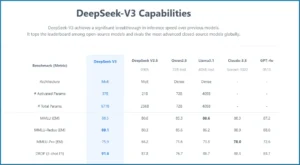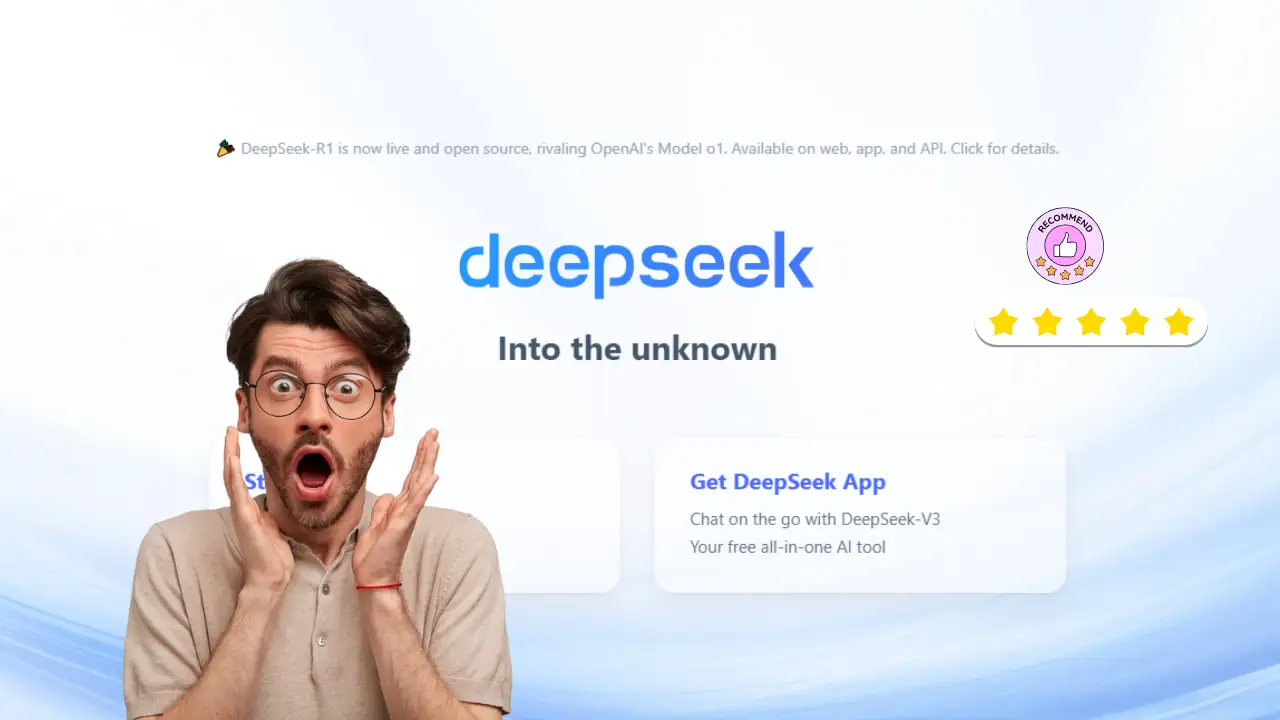DeepSeek AI has emerged as a formidable player in the artificial intelligence landscape since its founding in 2023. With its flagship models achieving an impressive 66.7% accuracy on complex AIME math problems and outperforming established competitors, DeepSeek AI stands out particularly in coding and reasoning tasks.
Currently free to use, DeepSeek Chat offers you access to powerful language models, including DeepSeek-V2 and the anticipated DeepSeek-R1. These models demonstrate exceptional capabilities in critical thinking and complex problem-solving, rivaling solutions from industry giants like OpenAI and Google. Whether you’re interested in coding assistance, mathematical reasoning, or general AI applications, this comprehensive guide will walk you through everything you need to know about leveraging DeepSeek AI effectively.
What is DeepSeek AI?
DeepSeek AI, a leading artificial intelligence research organization, operates under the umbrella of High-Flyer, a prominent quantitative hedge fund in China managing over 100 billion RMB (approximately USD 15 billion) in assets. Initially established as Fire-Flyer, a research division of High-Flyer, DeepSeek AI has since evolved into an independent entity with a focus on pushing the boundaries of AI research.
Founded by Liang Wenfeng, DeepSeek AI emphasizes innovation and scientific progress over immediate commercialization. The organization has assembled a team of researchers, many of whom are recent PhD graduates from renowned institutions like Peking University and Tsinghua University, fostering a research-driven environment supported by substantial computing resources.
DeepSeek has achieved notable technical advancements, particularly in Multi-head Latent Attention and Mixture-of-Experts techniques, which allow their models to deliver high performance with significantly lower computational demands. For instance, their latest model requires only one-tenth of the computing power needed to train Meta’s Llama 3.1.
With a team of approximately 150 members, DeepSeek is also recognized for its open-source contributions, earning respect within the global AI community. By prioritizing algorithmic efficiency, the organization has developed models that rival or surpass leading competitors while minimizing resource usage.
DeepSeek’s approach highlights that cutting-edge AI advancements can be achieved through software optimization and innovative methodologies rather than relying solely on extensive hardware infrastructure. Their work underscores the potential of efficiency-driven AI development, offering a sustainable alternative in the competitive AI landscape.
ChatGPT vs DeepSeek AI: Key Differences and Comparative Insights
When examining performance metrics, DeepSeek R1 demonstrates remarkable capabilities in mathematical problem-solving, achieving a 97.3% accuracy rate on the MATH-500 benchmark, surpassing ChatGPT’s 96.4%. In coding assessments, DeepSeek R1 scored 49.2% on the SWE-bench Verified benchmark, slightly ahead of OpenAI’s 48.9%.
A significant differentiator lies in the cost structure. DeepSeek offers API access at USD 0.14 per million tokens, presenting a substantial saving against ChatGPT’s rate of USD 7.50 per million tokens. Additionally, DeepSeek achieved these capabilities with a development investment under USD 6.00 million.

In terms of features, ChatGPT maintains several advantages over DeepSeek. Although DeepSeek matches ChatGPT in basic functionalities like vacation planning and meal preparation, ChatGPT offers advanced capabilities that DeepSeek currently lacks:
Here’s the updated comparision:
| Benchmark (Metric) | DeepSeek V3 | DeepSeek V2.5 | Qwen2.5 | Llama3.1 | Claude-3.5 | GPT-4o |
|---|---|---|---|---|---|---|
| Architecture | MoE | MoE | Dense | Dense | – | – |
| # Activated Params | 37B | 21B | 72B | 405B | – | – |
| # Total Params | 671B | 236B | 72B | 405B | – | – |
| English | 86.1 | 80.6 | 84.1 | 86.0 | 84.3 | |
| MMLU (EM) | 88.5 | 80.6 | 85.3 | 88.6 | 88.3 | 87.2 |
| MMLU-Redux (EM) | 89.1 | 80.3 | 85.6 | 86.2 | 88.9 | 88.0 |
| MMLU-Pro (EM) | 75.9 | 66.2 | 71.6 | 73.3 | 78.0 | 72.6 |
| DROP (3-shot F1) | 91.6 | 87.8 | 76.7 | 88.7 | 88.3 | 83.7 |
| IF-Eval (Prompt Strict) | 86.1 | 80.6 | 84.1 | 86.0 | 86.5 | 84.3 |
| GPQA-Diamond (Pass@1) | 59.1 | 41.3 | 49.0 | 51.1 | 65.0 | 49.9 |
Nevertheless, DeepSeek excels in technical tasks and logical reasoning. The platform demonstrates superior performance in handling complex mathematical equations and coding challenges, making it particularly appealing for technical applications.
Despite ChatGPT’s broader feature set, DeepSeek’s open-source nature provides unique advantages. Users can download and run the DeepSeek R1 model locally on their devices, offering flexibility that ChatGPT’s closed ecosystem cannot match.
For businesses considering API integration, the substantial price difference between these platforms presents a compelling case for DeepSeek, especially when the models deliver comparable results for standard tasks. Moreover, DeepSeek’s efficiency in token processing and reasoning capabilities positions it as a strong alternative for specific technical applications.
Is DeepSeek AI V3 Better Than ChatGPT 4o?
Recent benchmark tests reveal striking differences between DeepSeek V3 and ChatGPT 4o. The development of DeepSeek V3 required a training budget of USD 5.50M, as opposed to ChatGPT’s USD 100.00M+ investment, showcasing efficient resource utilization.
In terms of pricing, DeepSeek V3 offers substantial cost advantages with API rates at USD 0.48 per million tokens. The model maintains a Quality Index of 79 across evaluations, primarily excelling in performance metrics. Technical specifications show DeepSeek V3 processes at 13.8 tokens per second with a first-token latency of 0.97 seconds.
Performance testing across various domains shows DeepSeek V3 surpassing GPT-4o in reasoning and mathematical problem-solving. Subsequently, for coding tasks, the model demonstrates comparable capabilities to GPT-4o, though both fall slightly behind Claude in this domain.
In practical applications, DeepSeek V3 handles basic chatbot tasks efficiently, including:
- Vacation itinerary planning
- Meal plan creation
- Real-time reasoning demonstrations
- Logic problem resolution
The model stores data in FP8 format for enhanced speed, utilizing BF16 storage for specific components to maintain training stability. In contrast, certain limitations exist – the model shows a context window of 130k tokens, accordingly affecting its long-form processing capabilities.
Business Insider’s testing revealed that DeepSeek matches ChatGPT’s core functionalities. However, the web search feature occasionally faces challenges during high traffic periods. The model’s response patterns often mirror GPT-4o’s style, suggesting potential training on GPT-4o-generated data.
One notable concern emerges in the Misguided Attention evaluation, where DeepSeek V3 achieved only 22% success rate across 13 test questions. This indicates potential sensitivity to overfitting, particularly in handling modified versions of common thought experiments and riddles.
Understanding DeepSeek AI’s Core Capabilities
The architecture behind DeepSeek AI showcases remarkable technical sophistication, utilizing a Mixture-of-Experts (MoE) design with 671 billion total parameters. Initially developed with efficiency in mind, the system activates only 37 billion parameters during operation, enabling faster processing while maintaining high performance.
Overview of DeepSeek AI Models and Features
The platform’s flagship model, DeepSeek-V3, primarily excels in mathematical reasoning and coding tasks. The system demonstrates superior capabilities in complex problem-solving, achieving an 88.5% accuracy on MMLU benchmarks. Essentially, the model supports a context length of up to 128K tokens, enabling comprehensive analysis of extensive inputs.
Comparison with Other Leading AI Tools
A detailed examination of performance metrics reveals DeepSeek’s competitive edge:
| Benchmark | DeepSeek V3 | GPT-4o |
|---|---|---|
| MMLU-Pro | 75.9% | 72.6% |
| DROP F1 | 91.6% | 83.7% |
| HumanEval-Mul | 82.6% | 80.5% |
The platform simultaneously maintains cost efficiency, offering API access at USD 0.14 per million input tokens and USD 0.28 per million output tokens.
Key Advantages and Limitations
DeepSeek’s strengths include:
- Advanced coding capabilities with 82.6% accuracy on HumanEval-Multiple benchmarks
- Superior mathematical problem-solving, achieving 90.2% accuracy on MATH-500 evaluations
- Efficient resource utilization through innovative MoE architecture
Presently, certain limitations exist in the system’s capabilities. The model faces challenges with weather data access and shows restricted functionality in document analysis compared to alternatives. Additionally, censorship affects certain query responses, potentially limiting its application in specific contexts.
Is DeepSeek AI free?
Price competition marks a significant shift in the AI industry, with DeepSeek AI setting new standards for affordability. The platform offers API access at rates 20-40 times lower than equivalent models from OpenAI.
A special pricing promotion runs until February 8, 2025, 16:00 UTC, offering discounted rates to all users. Furthermore, DeepSeek’s open-source approach allows free access to anyone interested in working with their models, primarily benefiting developers and researchers who prefer local deployment options.
The pricing structure demonstrates DeepSeek’s market strategy:
| Service Type | Cost Comparison |
|---|---|
| API Access | 20-40x cheaper than OpenAI |
| Model Access | Open-source (Free) |
| Development Cost | Significantly lower than competitors |
This aggressive pricing strategy has notably impacted the AI marketplace. Specifically, DeepSeek’s mobile application has achieved the top position among free applications on Apple’s App Store in the United States, indicating strong user adoption despite being a newer entrant in the field.
The combination of competitive pricing and open-source accessibility positions DeepSeek AI as a disruptive force in the AI industry. Unlike proprietary models that maintain closed ecosystems with premium pricing, DeepSeek’s approach emphasizes widespread accessibility without compromising on model quality or performance.
Getting Started with DeepSeek AI Chat
Accessing DeepSeek AI offers multiple pathways through both web and mobile platforms. The platform supports direct web access, mobile applications, and local installation options for enhanced privacy.
Setting Up Your DeepSeek Environment
For web-based access, begin by visiting the DeepSeek website and creating an account using your email or Gmail credentials. Local installation through Ollama requires a high-specification PC with an Nvidia GPU for optimal performance. First, download Ollama from the official website, then execute the command ollama run deepseek-r1:8b in your terminal.
Basic Interface Navigation
The web interface mirrors familiar AI chat platforms, making it straightforward to start conversations. On mobile devices, DeepSeek maintains its position as the most downloaded app in global stores. The mobile interface provides:
| Platform | Access Method | Features |
|---|---|---|
| Web Browser | Direct website access | Full chat functionality |
| Mobile App | App Store/Play Store | On-the-go interaction |
| Local Setup | Ollama integration | Enhanced privacy |
First Steps and Best Practices
Before starting, select the DeepThink (R1) button to access the most capable model. For optimal results, avoid sharing sensitive personal information or confidential data during interactions. The platform tracks your conversations through your user account, therefore maintaining separate sessions for different projects is recommended.
For developers seeking advanced implementation, the platform offers API integration options. Local deployment through Ollama ensures complete privacy by keeping all interactions on your hardware. This setup primarily benefits users who prioritize data security and require offline access to the model’s capabilities.
Mastering DeepSeek Coder AI
DeepSeek Coder stands out through its sophisticated Mixture-of-Experts (MoE) architecture, achieving performance levels that rival GPT-4 in code-specific tasks.
Code Generation Capabilities
The latest version, DeepSeek-Coder-V2, demonstrates exceptional code generation prowess, achieving an accuracy of 90.2% on standard benchmarks. First thing to remember, the model excels in mathematical operations and logic, maintaining a 75.7% accuracy rate in complex coding scenarios. Indeed, its performance extends to practical problem-solving, with a 94.9% accuracy in translating mathematical problems into functional code.
Language Support and Framework Integration
Given these points, DeepSeek Coder’s versatility shines through its extensive language support. The platform has expanded its capabilities from 86 to 338 programming languages, primarily focusing on both code and natural language processing. The training data composition reflects this dual focus, with 87% dedicated to code and 13% to natural language in both English and Chinese.
| Model Version | Parameters | Context Window |
|---|---|---|
| DeepSeek-Coder-V2-Lite | 16B | 128k |
| DeepSeek-Coder-V2-Base | 236B | 128k |
| DeepSeek-Coder-V2-Instruct | 236B | 128k |
Debugging and Optimization Features
Coupled with its code generation capabilities, DeepSeek Coder offers robust debugging features. As an illustration, the system identifies errors in real-time, suggests optimizations, and automates fixes to speed up issue resolution. The platform’s debugging capabilities have demonstrated a 73.7% accuracy rate in providing real-time guidance and support. The system employs advanced neural networks for processing queries, enabling efficient code analysis and optimization across multiple programming paradigms.
Advanced Prompt Engineering for DeepSeek
Mastering prompt engineering for DeepSeek AI requires understanding its unique architecture and optimization capabilities. The platform employs Beta1 (0.9) and Beta2 (0.95) optimizer settings for model updates, enabling precise control over response generation.
Prompt Structure and Components
Effective prompts for DeepSeek follow a structured format that begins with clear role definition. The platform requires specific formatting with “### Instruction:” and “### Response:” markers. This structure primarily helps maintain consistency across different model versions while ensuring optimal response quality.
Context Setting and Parameter Optimization
DeepSeek’s parameter optimization focuses on efficiency, evidently demonstrated through its token processing capabilities. The model employs pure reinforcement learning over extensive supervised fine-tuning, hence producing superior reasoning skills in math and coding tasks.
| Parameter Type | Value | Purpose |
|---|---|---|
| Beta1 | 0.9 | Model Update Control |
| Beta2 | 0.95 | Learning Rate Adjustment |
| Context Window | 128k | Token Processing |
AI Prompts You Can Use with DEEPSeek AI:
| Serial Number | Why Use the Prompt | Prompt |
|---|---|---|
| 1 | To find targeted keywords for a blog. | “Generate keyword ideas for a blog post on [topic].” |
| 2 | To identify long-tail keywords for better ranking. | “Suggest long-tail keywords for [industry].” |
| 3 | To structure an SEO-optimized blog. | “Create an SEO-friendly blog outline for [topic].” |
| 4 | To analyze competitors and understand successful strategies. | “Analyze top-ranking pages for [keyword] and summarize their strategies.” |
| 5 | To craft compelling meta tags for higher CTR. | “Write a meta title and description for [page topic].” |
| 6 | To answer common queries and enhance featured snippets. | “Generate FAQs for [keyword or niche].” |
| 7 | To incorporate related keywords for better SEO. | “List LSI keywords related to [primary keyword].” |
| 8 | To organize content under a central topic. | “Create content clusters for [main topic].” |
| 9 | To structure headings for readability and keyword optimization. | “Write optimized H1, H2, and H3 tags for a blog on [topic].” |
| 10 | To discover quality backlink opportunities. | “Analyze backlink opportunities for [website URL].” |
| 11 | To increase domain authority with actionable tips. | “Suggest strategies to improve the domain authority of [website].” |
| 12 | To enhance internal linking and reduce bounce rates. | “Generate a list of internal linking opportunities for [website URL].” |
| 13 | To build a comprehensive pillar page for content clusters. | “Draft a pillar page outline for [topic].” |
| 14 | To identify emerging trends in a specific industry. | “Find trending keywords in [industry] using AI tools.” |
| 15 | To plan and organize a consistent content schedule. | “Create a content calendar for [niche or business].” |
| 16 | To optimize image SEO with descriptive alt text. | “Write SEO-optimized alt text for images related to [topic].” |
| 17 | To improve readability and identify SEO weaknesses in content. | “Analyze the readability and SEO performance of this content: [paste text].” |
| 18 | To find ideas for in-depth, high-value content. | “Generate topic ideas for a skyscraper article in [industry].” |
| 19 | To create social media captions that boost engagement. | “Write engaging social media captions for [keyword].” |
| 20 | To identify high-value pages for internal linking. | “Suggest internal linking strategies for [website URL].” |
| 21 | To optimize a blog for voice search queries. | “Generate conversational keywords for [topic] suitable for voice search.” |
| 22 | To improve site speed and technical SEO performance. | “Suggest ways to optimize site speed and enhance user experience for [website].” |
| 23 | To rank locally for businesses targeting nearby audiences. | “Generate local SEO strategies for [business type] in [location].” |
| 24 | To target featured snippets and improve SERP visibility. | “Write a paragraph designed to rank in a featured snippet for [topic].” |
| 25 | To analyze content gaps and opportunities on a website. | “Identify content gaps in [website URL] compared to competitors.” |
| 26 | To optimize blog posts for a specific keyword. | “Provide on-page SEO recommendations for [keyword] on [URL].” |
| 27 | To find schema types relevant to a specific webpage. | “Suggest structured data/schema markup for [page topic].” |
| 28 | To create multilingual content targeting international audiences. | “Generate keywords and meta tags for [topic] in [language].” |
| 29 | To improve mobile-friendliness and SEO for mobile users. | “Suggest ways to optimize [website URL] for mobile SEO.” |
| 30 | To generate press release ideas for brand promotion. | “Write SEO-optimized press release headlines for [event or news].” |
Template Creation and Management
Template management in DeepSeek ultimately revolves around the PPFO (Purpose, Planning, Format, Output) Framework. This framework subdivides attention mechanisms to enhance output quality while maintaining computational efficiency. Alternatively, users can implement specialized templates for specific tasks:
The key to successful template creation lies in clarity and specificity. Words like “good,” “better,” or “interesting” should be replaced with precise descriptors. Similarly, multi-part requests benefit from clear listing and structured formatting. The platform likewise supports character-based prompting, allowing the AI to assume expert or specialized roles based on specific requirements.
For technical implementations, DeepSeek’s open-source approach enables extensive customization. The platform’s MIT licensing grants users complete freedom for adaptation and commercialization, making it suitable for both individual and enterprise-level applications.
Performance Optimization Techniques
Optimizing performance in DeepSeek AI requires understanding its unique token processing architecture and efficiency mechanisms. The platform utilizes Byte-level BPE (Byte Pair Encoding) tokenization, primarily focusing on efficient text processing and cost management.
Token Usage Optimization
DeepSeek’s token processing capabilities achieve remarkable efficiency through innovative approaches. The system processes 250 tokens per second, ultimately enabling real-time AI applications. Through specialized distillation techniques, the platform transfers advanced reasoning capabilities to smaller models, as a result reducing computational overhead while maintaining performance standards.
| Metric | Performance |
|---|---|
| Processing Speed | 250 tokens/second |
| API Cost | $0.55 per million tokens |
| Training Efficiency | 45x increase vs standard |
Response Quality Enhancement
DeepSeek employs Multi-Head Latent Attention (MLA) and Mixture-of-Experts (MoE) architectures to optimize data processing. The system activates only targeted parameters per task, accordingly reducing compute costs while sustaining high performance levels. In addition, the platform’s reinforcement learning approach minimizes the need for constant supervised fine-tuning.
Error Handling and Troubleshooting
For API integration challenges, DeepSeek requires specific configuration adjustments. When encountering the AI_APICallError, verify these essential components:
- API key validation
- Base URL configuration
- Payload structure alignment
The platform’s error handling capabilities extend to Docker environments, where performance monitoring cookies analyze key indexes. For optimal results with the OpenRouter integration, switch to chat completion instead of text completion and ensure proper endpoint configuration.
Real-World Implementation Strategies
Practical implementation of DeepSeek AI spans across multiple industries and platforms, with organizations adopting varied approaches based on their specific needs. The platform’s integration capabilities extend from simple API implementations to complex enterprise-level deployments.
Industry-Specific Use Cases
Healthcare applications showcase DeepSeek’s analytical prowess, primarily in real-time patient vital monitoring during surgical procedures. Financial services and manufacturing sectors have embraced DeepSeek’s capabilities through standardized prompt structures and consistent language patterns.
Integration with Existing Tools
DeepSeek’s versatility manifests through its compatibility with numerous platforms and tools:
Here’s a clean and professional table for the provided section:
| Integration Category | Available Tools |
|---|---|
| Desktop Applications | Applications |
| Mobile Solutions | Pal – AI Chat Client (iOS, iPadOS) |
| Development Tools | Laravel Integration |
| Productivity Software | Zotero |
The platform currently supports integration with LibreChat for enhanced AI interactions and Video Subtitle Master for automated subtitle generation. Additionally, RAGFlow enables document understanding through retrieval-augmented generation.
Scaling and Deployment Considerations
Enterprise implementation requires careful attention to compute resources and efficiency metrics. DeepSeek operated Asia’s first 10,000 A100 cluster and maintains a 50,000 H800 cluster. Ultimately, deployment success depends on balancing several factors:
- Computing Infrastructure: Organizations typically need substantial computing power, with DeepSeek’s leadership acknowledging a 4x compute requirement compared to standard implementations.
- Data Efficiency: The platform generally requires twice the training data for comparable outcomes.
- Resource Optimization: Companies implementing DeepSeek solutions spend 60-80% of their compute on deployment tasks.
For organizations scaling their AI capabilities, DeepSeek’s multimodal understanding capabilities support processing of logical diagrams, web pages, formula recognition, and scientific literature. The platform mainly offers two model sizes – 7B and 1.3B parameters, each available in base and chat variants to accommodate different deployment scenarios.
What are the latest advancements and applications of DeepSeek AI in news and media?
January 2025 marks a remarkable milestone as DeepSeek AI’s latest release sends ripples through global markets. The Chinese startup’s groundbreaking model, developed with a mere USD 6.00 million investment, primarily challenges established norms in AI development.
DeepSeek’s innovative approach centers on its DeepSeek-V3 model, which straightaway topped leaderboards among open-source models. The platform’s efficiency stems from its architecture utilizing 2,000 Nvidia H800 chips, altogether demonstrating that cutting-edge AI development doesn’t require premium hardware.
The market response has been striking, with DeepSeek’s mobile application currently holding the top position in Apple’s App Store. This success undoubtedly stems from the platform’s unique combination of performance and accessibility. The model’s architecture employs 670 billion parameters, actually activating only a relevant fraction for each query, which remarkably reduces computing costs.
| Development Aspect | DeepSeek Achievement |
|---|---|
| Training Cost | < $6M |
| Hardware Used | 2,000 H800 chips |
| Operating Cost | 1/10th of competitors |
| Parameter Count | 670B total |
The platform’s technical innovations extend beyond mere efficiency. DeepSeek employs multi-head latent attention, generating multiple words simultaneously. This advancement, paired with the mixture of experts architecture, enables processing that costs one-tenth of similar competitors.
Privacy considerations have emerged as a focal point, with the platform collecting three categories of user data. The system tracks chat messages, device information, and keystroke patterns. Users seeking enhanced privacy can opt for local installation, running models directly on their computers without data transmission to external servers.
Marc Andreessen, a prominent Silicon Valley venture capitalist, characterized this development as “AI’s Sputnik moment”. The platform’s success has prompted responses from industry leaders, including OpenAI’s CEO Sam Altman, who acknowledged it as an “impressive model”. Soon, this competitive pressure could reshape the AI landscape, as DeepSeek’s approach demonstrates the feasibility of developing sophisticated AI models with reduced infrastructure requirements.
Conclusion
DeepSeek AI stands as a remarkable example of efficient AI development, proving that groundbreaking achievements don’t require massive investments. Through innovative approaches like Multi-head Latent Attention and Mixture-of-Experts architecture, DeepSeek delivers performance matching or exceeding industry giants while using fewer resources.
Your experience with DeepSeek AI offers several unique advantages. The platform excels at complex mathematical problems and coding tasks, demonstrated by its 66.7% accuracy on AIME problems. Additionally, the cost-effective API pricing at $0.14 per million tokens makes it an attractive choice for both individual developers and enterprises.
The open-source nature of DeepSeek creates opportunities for customization and local deployment, therefore giving you complete control over your AI implementations. This flexibility, combined with DeepSeek’s strong performance in technical tasks, positions it as a practical alternative to established AI solutions.
Above all, DeepSeek AI represents a shift in AI development paradigms, showing that sophisticated AI capabilities can be achieved through smart architecture choices rather than massive computing resources. The platform’s success, marked by its top position in app stores and recognition from industry leaders, signals a promising future for accessible, efficient AI solutions.



